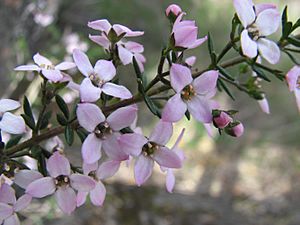Whorled zieria facts for kids
Quick facts for kids Whorled zieria |
|
|---|---|
 |
|
| Zieria aspalathoides at Kooyoora State Park, Victoria | |
| Scientific classification | |
| Genus: |
Zieria
|
| Species: |
aspalathoides
|
| Synonyms | |
|
Zieria laevigata var. aspalathoides (A.Cunn. ex Benth.) C.Moore & Betche |
|
The Zieria aspalathoides, often called the whorled zieria, is a special plant. It belongs to the citrus family called Rutaceae. This plant only grows in eastern Australia, meaning it is endemic there. It looks like a small heath shrub. Its leaves seem to grow in a circle, which is called a whorl. The plant has pretty pink flowers. These flowers usually grow in groups of three. Each flower has four petals and four stamens.
What it Looks Like
The Whorled zieria is a shrub that looks like a heath plant. It can grow to be about 1 to 1.5 metres (3 to 5 feet) tall. Its branches have ridges and might feel scaly or hairy, especially when they are young.
The leaves are made up of three small parts called leaflets. These leaflets are long and narrow, about 5 to 8 millimetres (0.2 to 0.3 inches) long. They are about 1 to 1.3 millimetres (0.04 to 0.05 inches) wide. The leaves have a very short stalk, less than 1 millimetre long. They grow in pairs opposite each other on the stem. This makes it look like there are six simple leaves in a circle, or whorl. The edges of the leaflets curl under. The top side of the leaf is a darker green than the bottom side.
The flowers are usually pale to deep pink. They grow in groups, mostly with three flowers together. These groups are usually longer than the leaves. The small, leaf-like parts under the petals are called sepals. They are shaped like triangles, about 1.4 millimetres (0.06 inches) long. Sepals are usually smooth but can be hairy.
Each flower has four petals. These petals are about 4 to 5.5 millimetres (0.16 to 0.22 inches) long. They overlap each other at the edges. The petals are covered with short, soft hairs. Inside the flower, there are four stamens, which are the parts that make pollen.
The Whorled zieria flowers from late winter to early summer. After the flowers, the plant produces fruit. This fruit is a dry pod called a follicle. It is mostly smooth (which means glabrous). The follicle contains black seeds.
How it Got its Name
The plant Zieria aspalathoides was first officially described in 1863. This was done by George Bentham. He used notes from an earlier, unpublished description by Allan Cunningham. Bentham's description was then printed in a book called Flora Australiensis.
The second part of the plant's scientific name, aspalathoides, tells us something interesting. It means the plant looks similar to plants in another group called Aspalathus. The ending -oides comes from Latin and means "likeness" or "similar to."
Scientists have found two slightly different types of this plant, called subspecies:
- Zieria aspalathoides subsp. aspalathoides: This type has at least some leaflets that are longer than 4 millimetres (0.16 inches).
- Zieria aspalathoides subsp. brachyphylla: This type has leaflets that are shorter than 3 millimetres (0.12 inches).
Where it Lives
This zieria plant grows in three states in Australia: Queensland, New South Wales, and Victoria. It likes to grow in dry forests and heathlands. You can often find it in sandy soil, and sometimes it grows between rocks.
The subspecies aspalathoides is found in many places. It grows from Victoria all the way up to the Atherton Tableland in Queensland. However, in Victoria, it only grows in a few separate spots. In New South Wales, you can find it on the tablelands and western slopes.
The other subspecies, brachyphylla, is much rarer. It only grows in one specific place: the Blackdown Tableland in Queensland.
See also
 In Spanish: Zieria aspalathoides para niños
In Spanish: Zieria aspalathoides para niños

